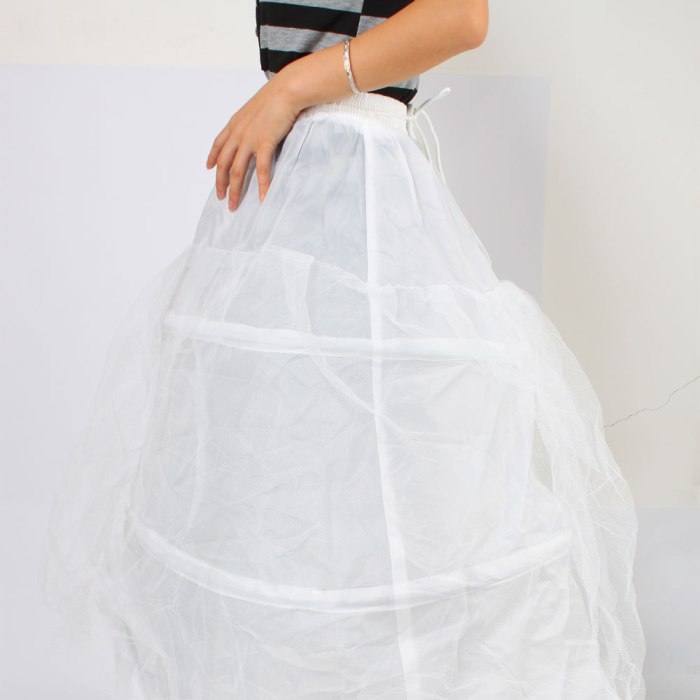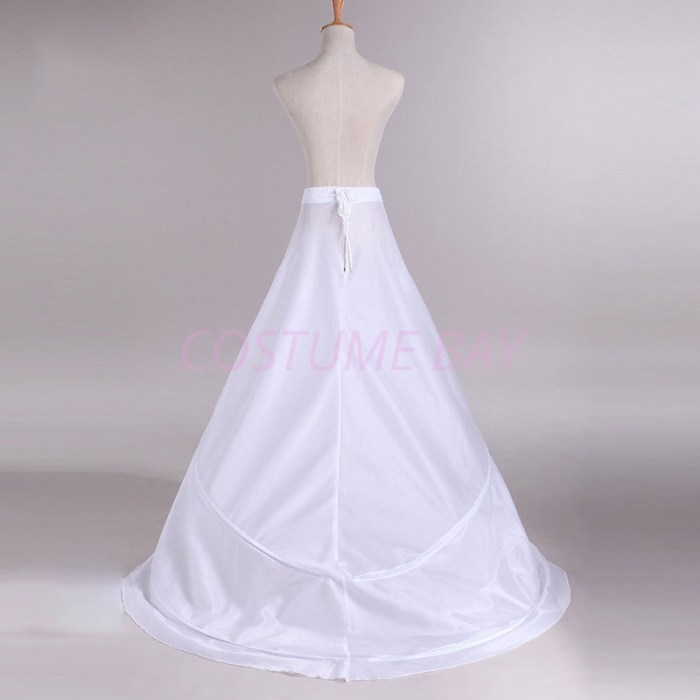Understanding the Components of a Wedding Dress
Parts of a wedding dress – A wedding dress is more than just fabric; it’s a culmination of artistry, craftsmanship, and personal style. Understanding its various components allows for a more informed selection process, ensuring the dress perfectly complements the bride’s vision and body type. This exploration delves into the key elements: the bodice, skirt, train, veil, accessories, and the fabrics that bring them to life.
Bodice Styles and Construction
The bodice, the upper part of the dress, significantly impacts the overall silhouette and aesthetic. Numerous styles cater to diverse preferences and body shapes. Sweetheart necklines, with their romantic curves, have enduring appeal, while strapless bodices offer a modern, sleek look. Halter necklines provide elegant support and highlight the shoulders and neck. Historically, bodices reflected prevailing fashion trends; the corseted bodices of the Victorian era contrast sharply with the simpler, more flowing styles of the 1920s.
Fabrics like silk, satin, lace, and crepe are frequently used for bodices, each offering unique properties. Silk provides luxurious drape and sheen, while satin offers a smooth, lustrous finish. Lace adds intricate detailing and texture, and crepe provides structure and a matte finish. The choice of fabric influences the overall feel and drape of the bodice.
Constructing a bodice involves meticulous techniques. Seams must be precisely aligned and finished to ensure durability and a clean aesthetic. Boning provides structure and support, shaping the bodice and creating a defined silhouette. Closures, such as zippers, hooks and eyes, or lacing, secure the bodice comfortably and invisibly.
Bodice Designs for Different Body Types
Three bodice designs tailored to different body types are presented below. These examples showcase how design can enhance individual features.
- A-line Bodice for Hourglass Figure: This style accentuates the waist while gracefully flowing over the hips. A sweetheart neckline adds a touch of romance. The bodice is constructed with boning for support and shaping, using a structured fabric like crepe or brocade.
- Empire Waist Bodice for Petite Figure: This style features a high waistline, creating a lengthening effect that visually elongates the torso. A simple, clean neckline, like a bateau or V-neck, complements the style. Lightweight fabrics like chiffon or silk georgette are ideal for this design.
- Structured Bodice for Athletic Figure: This style emphasizes a defined silhouette through structured seams and boning. A structured fabric such as brocade or a heavier silk is appropriate. A V-neck or square neckline balances the shoulders.
Skirt Shapes and Silhouettes
The skirt significantly contributes to the overall aesthetic of the wedding dress. A-line skirts offer a flattering, universally appealing shape, while ballgown skirts exude classic elegance with their full, voluminous silhouette. Mermaid skirts create a dramatic, form-fitting look that flares out at the knees, and sheath skirts offer a sleek, modern aesthetic. The selection depends on personal preference, venue, and body type.
Fabric choices for skirts impact the overall look. Tulle creates volume and lightness, while satin offers a smooth, elegant drape. Lace adds intricate detailing, and organza provides a crisp, structured finish. The fabric’s weight and texture influence the skirt’s movement and overall appearance.
Creating volume and structure in skirts often involves techniques such as using crinolines and petticoats. Crinolines provide a foundational layer of support and volume, while petticoats add layers of fabric to enhance fullness and create a smooth, flowing silhouette.
Skirt Style Suitability
| Style | Venue | Theme | Description |
|---|---|---|---|
| A-line | Church, Garden, Ballroom | Classic, Romantic, Rustic | Flattering and versatile, suitable for various settings. |
| Ballgown | Ballroom, Grand Estate | Formal, Traditional | Exudes elegance and grandeur, ideal for formal settings. |
| Mermaid | Ballroom, Formal Reception | Glamorous, Modern | Dramatic and figure-hugging, perfect for showcasing curves. |
| Sheath | Modern Venue, City Hall | Minimalist, Modern | Sleek and sophisticated, ideal for a contemporary aesthetic. |
Train Lengths and Considerations
The train, the extension of fabric at the back of the dress, adds drama and elegance. Chapel trains extend to the floor and slightly beyond, while cathedral trains sweep several feet behind the bride. Sweep trains are shorter, extending only a few inches from the hem. The length significantly impacts the overall look and feel of the dress, adding a touch of classic elegance or a more dramatic, flowing effect.
Wearing a train involves practical considerations. Longer trains require more attention and may necessitate assistance during movement. The venue’s flooring and the bride’s comfort level should be considered when choosing a train length.
Cathedral Train Description
Imagine a wedding dress with a breathtaking cathedral train, cascading several feet behind the bride. The train is crafted from layers of luxurious silk chiffon, creating a soft, ethereal flow. Delicate lace appliqués adorn the edges of the train, adding a touch of intricate detail. The train is carefully constructed to maintain its shape and prevent dragging on the ground, with layers of tulle and horsehair adding structure and volume.
A wedding dress comprises several key parts: the bodice, skirt, train, and veil, each contributing to the overall design. The style of the sleeves is a significant detail, and a popular choice is the elegant one sleeve wedding dress , which offers a unique and modern aesthetic. Other elements like the neckline and embellishments further personalize the final look, showcasing the bride’s individual style.
As the bride walks, the train gracefully sweeps behind her, leaving a trail of elegant fabric.
Veil Styles and Symbolism
Wedding veils hold cultural and symbolic significance, often representing purity, modesty, or good luck. Different styles cater to varied tastes and wedding themes. Birdcage veils offer a retro-chic look, blusher veils partially cover the face, and cathedral veils extend to the floor or even beyond.
Veils are typically made from tulle, lace, or silk, each material contributing a different texture and aesthetic. Tulle provides a delicate, sheer look, lace adds intricate detailing, and silk offers a luxurious, flowing finish. The material choice impacts the overall look and feel of the veil.
Unique Veil Designs
- Mantilla Veil for A-line Dress: A delicate lace mantilla veil, falling softly over the shoulders, complements the classic elegance of an A-line gown. The lace adds a touch of romantic detail.
- Short, Embroidered Veil for Sheath Dress: A short, embroidered veil, just reaching the shoulders, adds a touch of modern sophistication to a sleek sheath dress. The embroidery adds a unique and personalized touch.
- Cathedral Veil with Lace Trim for Ballgown: A long cathedral veil with delicate lace trim complements the grandeur of a ballgown. The length adds drama and elegance.
Wedding Dress Accessories
Accessories play a crucial role in enhancing or transforming the overall look of a wedding dress. Belts, sashes, jewelry, and other accessories can add a touch of personality, highlight specific features, or create a cohesive aesthetic.
The choice of materials and colors significantly impacts the overall effect. Delicate jewelry complements a minimalist look, while bolder statement pieces enhance a glamorous aesthetic. The color of the accessories should complement the dress’s color and style.
Accessories for Different Wedding Dress Styles

Source: amazonaws.com
- Minimalist Wedding Dress: A simple, delicate necklace, understated earrings, and a thin belt.
- Romantic Wedding Dress: A floral crown, delicate pearl earrings, and a flowing sash.
- Glamorous Wedding Dress: Statement earrings, a sparkling necklace, a jeweled belt, and a dramatic headpiece.
Wedding Dress Fabrics, Parts of a wedding dress
Various fabrics contribute unique qualities to a wedding dress. Silk offers luxurious drape and sheen, satin provides a smooth, lustrous finish, lace adds intricate detailing and texture, and tulle creates volume and lightness. Each fabric possesses distinct properties regarding drape, texture, cost, and care requirements.
Fabric Properties and Care

Source: com.au
| Fabric | Pros | Cons | Care |
|---|---|---|---|
| Silk | Luxurious drape, sheen | Expensive, delicate | Dry clean only |
| Satin | Smooth, lustrous finish | Can wrinkle easily | Dry clean or hand wash |
| Lace | Intricate detailing, texture | Can be delicate | Dry clean only |
| Tulle | Volume, lightness | Can be easily damaged | Dry clean or hand wash |
FAQ Compilation: Parts Of A Wedding Dress
What is the difference between a cathedral and chapel train?
A cathedral train is significantly longer than a chapel train, extending several feet behind the bride. A chapel train typically extends to the floor and a few feet beyond.
How do I choose the right veil length for my dress?
The veil length should complement the dress’s silhouette and train length. A shorter veil works well with simpler dresses, while a longer veil suits more elaborate gowns.
Can I alter a wedding dress to fit better?
Yes, alterations are common and often necessary to ensure a perfect fit. A seamstress can adjust the bodice, skirt, and train to create a flattering silhouette.
What fabrics are best for a summer wedding?
Lightweight fabrics like silk, chiffon, and organza are ideal for summer weddings as they are breathable and comfortable in warmer weather.
How do I clean my wedding dress after the wedding?
Professional dry cleaning is highly recommended to preserve the delicate fabrics and prevent damage. Follow the care instructions provided by the manufacturer.
